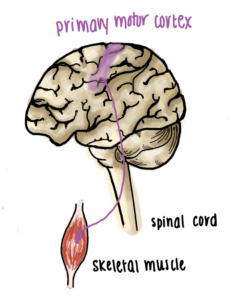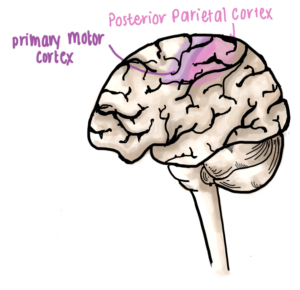Lay Summary by Tiffany Fong
Images by Crystal Han
Edited by Rona Herzog, Alanna Schwed and Alyssa Chong
This is a summary of the research article by Dr. Sue Peters, Shannon B. Lim, Dennis R. Louie, Dr. Chieh-ling Yang, and ICORD PI Dr. Janice Eng. To access the full article, click here.
The human brain is complicated! There are higher regions of the brain which are associated with more complex tasks and information processing (e.g., planning and reasoning) and there are lower regions of the brain that are associated with tasks that maintain basic human function (e.g., breathing, heartbeat, and maintaining upright posture).
When humans initiate walking, a number of higher brain regions coordinate multiple muscle groups throughout the body to move our limbs and maintain an upright posture. As we continue walking, our brains (higher and lower regions) receive sensory feedback about our environment to either maintain or adjust how we walk. This ensures our ability to continue moving safely and efficiently from point A to point B. This signal transfer between the brain and muscles is called neuromuscular communication.
Spinal cord injuries (SCI) disrupt neuromuscular communication and can have wide ranging effects on a person’s ability to walk. While aids such as wheelchairs and canes can improve mobility independence, these may not repair the neuromuscular communication impairment.
However, increasing brain activation post-injury through passive movement (i.e., having someone or something move one’s limbs) may improve neuroplasticity. This has the potential to help re-establish neuromuscular communication and possibly help regain movement abilities. The first step to rebuilding communication involves learning which brain regions are activated during both active and passive walking; this can help target areas for communication re-establishment and ultimately help guide clinical rehabilitation.
Purpose of the study
This study aimed to map and highlight differences in brain activation regions between passive and active overground walking (i.e., walking in an upright stance) using a robotic exoskeleton and functional near-infrared spectroscopy (fNIRS), which is a non-invasive neural imaging technology. The fNIRS devices are lightweight and portable; they can be applied to subjects while they are upright and moving.
What did we know before the study?
When walking without impairment, the posterior parietal cortex (PPC) primarily coordinates sensory feedback information from the environment (e.g., responses to objects or obstructions in the environment as well as sensing body position) to modify or adjust one’s walking pattern and maintain an upright posture.
What did the researchers find?
The major new finding of this study, aided by the use of fNIRS, was that the PPC is involved in the planning of the sequence of events involved with passive upright walking using the robotic exoskeleton. This is a function typically reserved for other motor regions of the brain under active conditions. In contrast, during active walking the PPC activation decreased.
How did they find this?
The aim of using fNIRS instead of the conventional fMRI technology was to be able to produce more realistic neural mapping during a person’s typical upright walking pattern under both active and passive conditions.
In comparison to fNIRS, functional magnetic resonance imaging (fMRI) machines have a large, stationary presence. In similar, previous studies fMRI machines have only been able to measure simulated walking patterns since the patient is lying on their backs in order to fit within the machine.
What does this mean for the SCI community?
Finding that the PPC is active during passive walking is significant as it indicates the extra resources required of the higher brain regions for planning limb coordination under passive conditions. This could be important for targeted exercises during SCI rehabilitation; where the PPC may not have previously been the focus, it may now be an important component for stimulation to improve neuromuscular communication for walking.
Definitions
Neuroplasticity: ability of neural networks in the brain to change through growth and reorganization
Active walking: user moves with the device
Passive walking: user is moved by the device
Overground walking: walking upright along ground surface
fNIRS: functional near-infrared spectroscopy; wearable neural imaging technology
PPC: posterior parietal cortex; area in the higher brain region that is involved in sensory and motor functions
fMRI: Functional magnetic resonance imaging; stationary neural imaging technology that requires patients to lie horizontally during scanning

